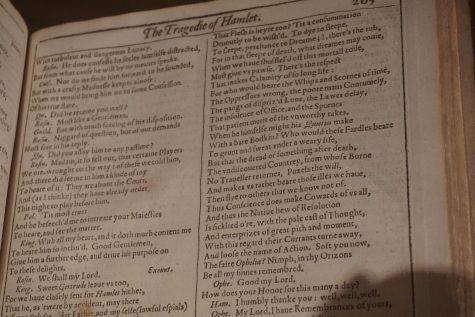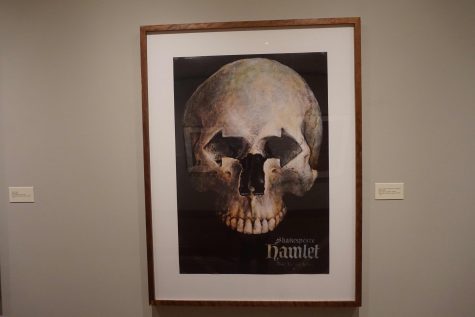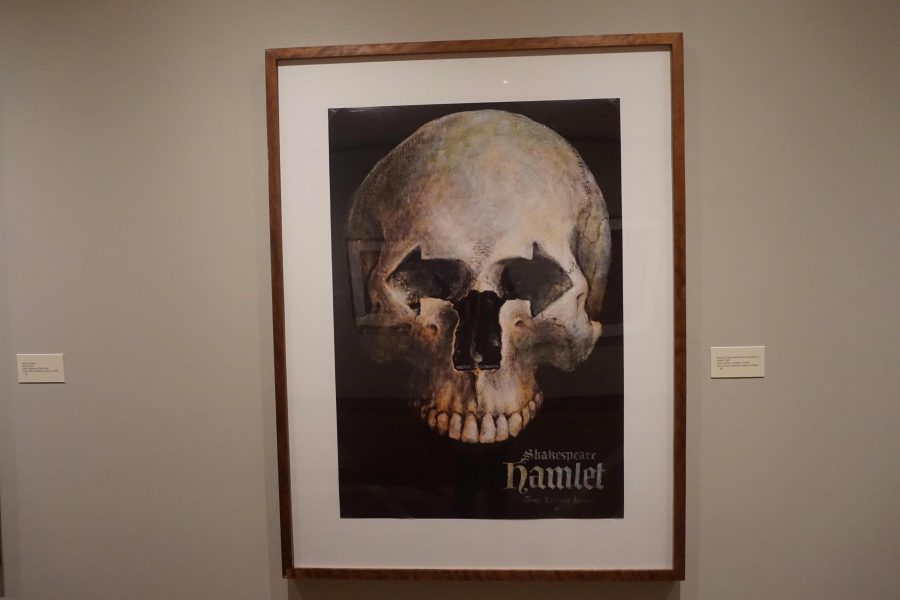Shakespeare’s Folio disappoints ardent fan
An artistic poster of Hamlet from either Poland or Russia; the room was pretty nice, but lacked energy as the rest of it was bare.
In preparation for the exciting day, I eagerly packed my camera, money, and a mind ready for anything that came my way. Why? I was about to see the first “Folio”, one of the first collections of all 36 of Shakespeare’s plays, compiled by the bard’s actors after his untimely death. This magnificent work is displayed at the Chazen Art Museum in Madison from Nov. to mid-Dec.
As I was greeted to the sleek, modern look in the museum, I was pleasantly surprised to find that due to donations, admission was free. After locating the exhibit, a lump formed in my throat as I realized that one of history’s greatest treasures remained separated from me by a short staircase. The stairs came to a short hallway, where two rooms branched out, telling of mystery. My heart jumped with each step towards the room at the end of the hallway.
I stepped into the room and was hit with a wall of disappointment. It was bare, aside from some informational posters detailing the significance of Shakespeare’s works, and a randomly-placed meme. The room itself possessed a darker lighting. On one side was a single glass case, with a guard lurking in the corner. Despite the let down, I still felt anxious to step towards the case and peer down at the magnificent manuscript.
The page was turned to Hamlet’s famous soliloquy, in which he expounds the wonders of life and death and whether living is truly worth it. It was incredibly exhilarating, observing each word and analyzing the differences between the old written text and the new. For starters, the S’s were written as F’s, and E’s were added onto the ends of some words.
Moving on from but not nearly finished with the folio, I went on to the next room, in which artistic posters of Hamlet from either Poland or Russia were presented. Most had skulls or bones depicted or were in angsty colors, but each was distinguished and unique in its own way. It was a nice touch to the room, but overall it lacked in energy as the rest of the room was bare, aside from a single couch in the middle.
I walked back into the main room and read the informational posters again. This time, one of them caught my eye. It was a list of every single play. Some were highlighted, indicating that without the Folio, they wouldn’t exist. They included were As You Like It, Julius Caesar, Macbeth, and The Tempest.
In honesty, I wish the exhibit was more interesting and larger, although it probably has something to do with the world’s utter disinterest or even hate towards Shakespeare, and due to the fact that the Chazen Art Museum has free entry. Also, the guard made enjoying the work a hard challenge to excel in, as his continuous glare dissuaded a discussion. Despite the fact that it was his duty to monitor surveillance at all times, his presence was the metaphorical elephant in the exhibit room.
Despite the shortcomings of this exhibit, I would recommend the Folio exhibit to others.

Viewing the manuscript open to Hamlet’s famous soliloquy was very exhilarating for Madison.

An artistic poster of Hamlet from either Poland or Russia; the room was pretty nice, but lacked energy as the rest of it was bare.










